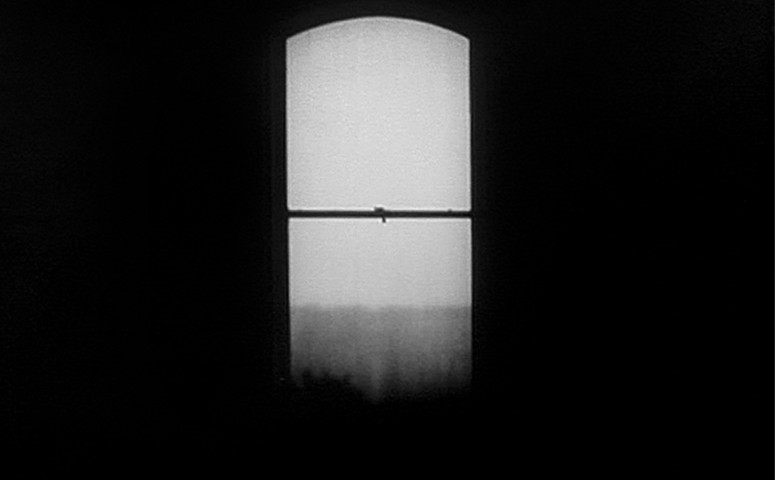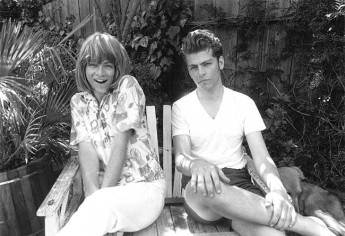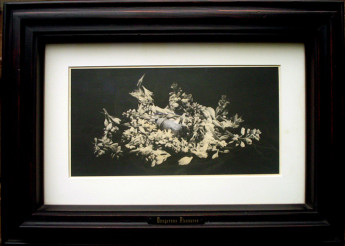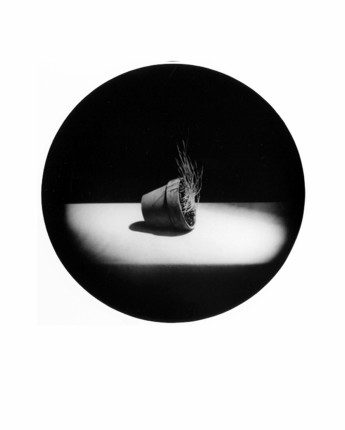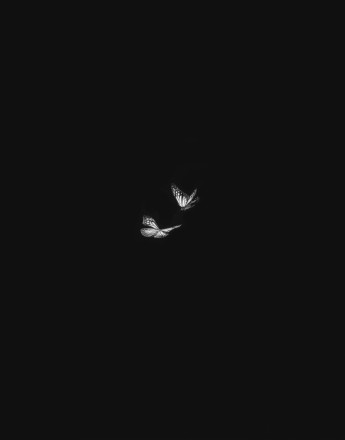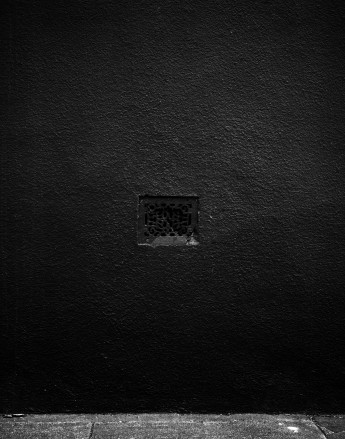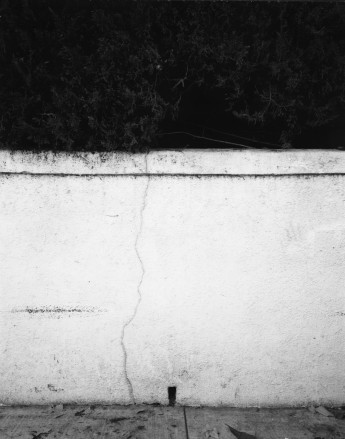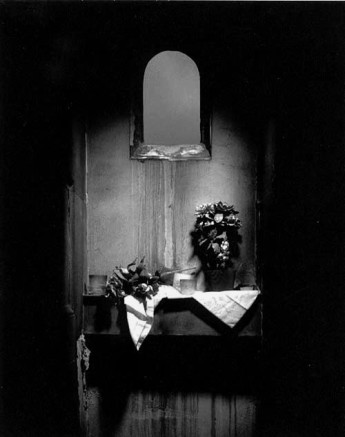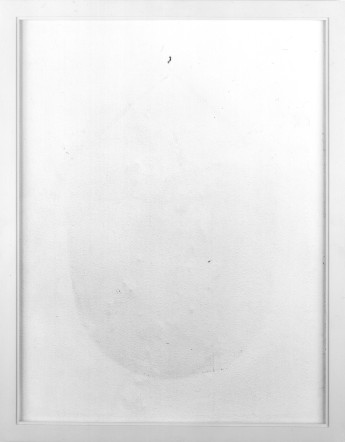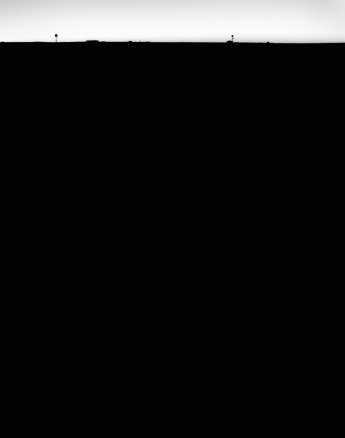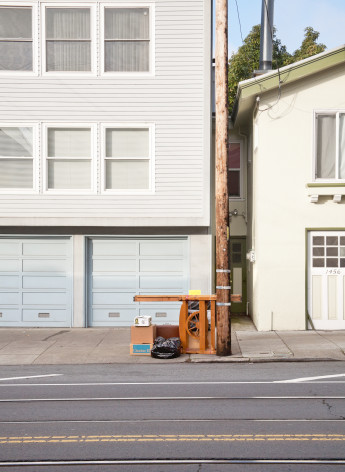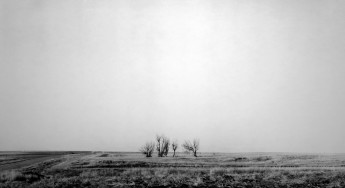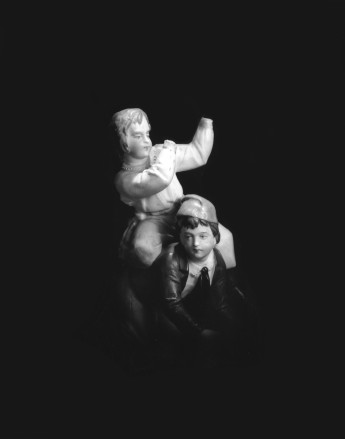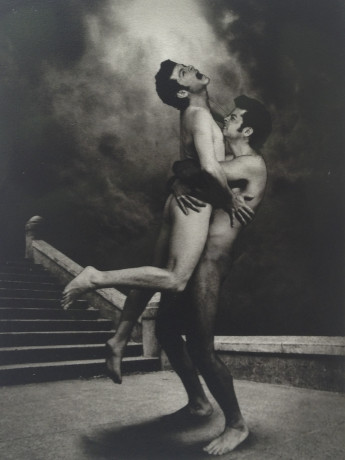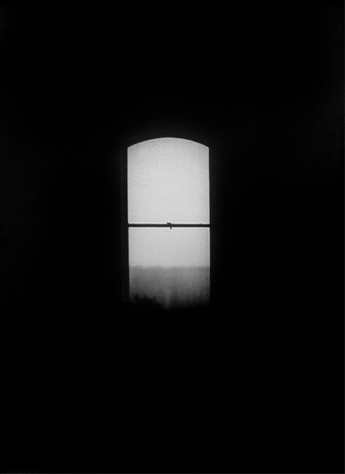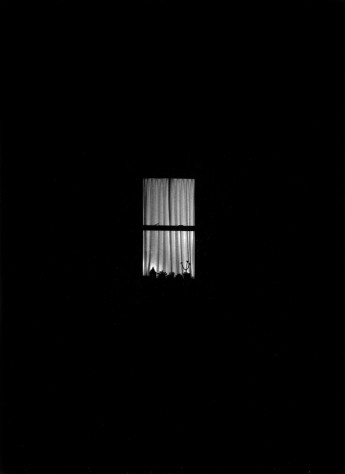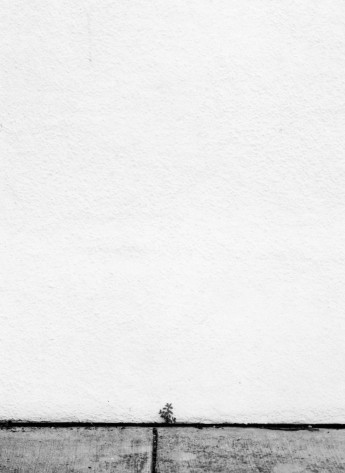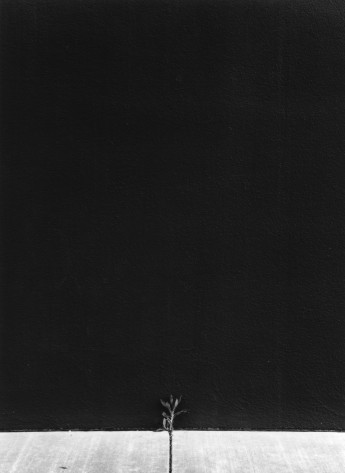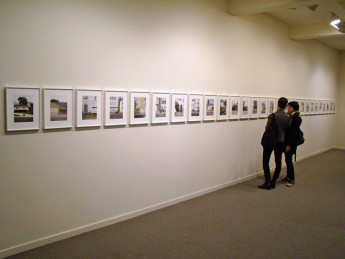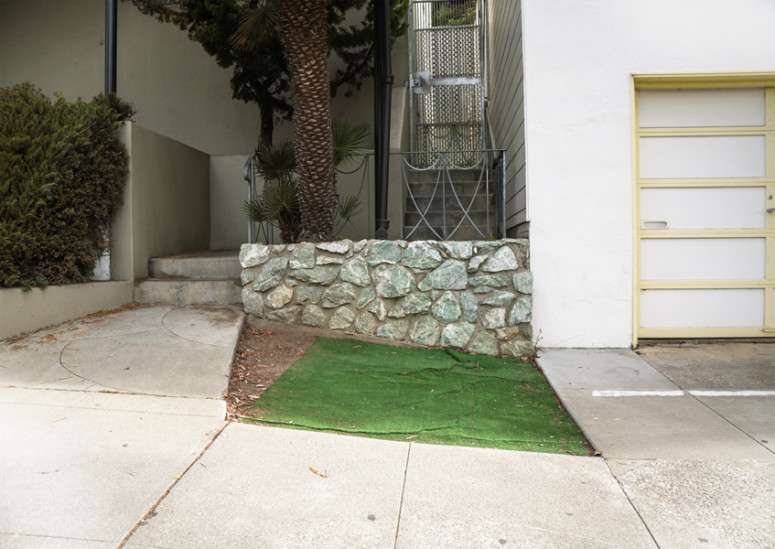In Part One, J. John Priola talked about his growing up and early work. In Part Two, we talk about his more mature work. He put out a number of pieces for us to discuss. He keeps his darkroom and archive downstairs in his house.
Q: This smell takes me back to the darkroom we had in our family basement.
John Priola: This isn’t bad. When I’m in the middle of printing, the smell is so much worse.
Q: Do you wait until you’ve got a backlog to print?
JJP: No. I just print when the series is done.
Q: When you’ve finished the idea, then you print?
JJP: Yes in general, but I edition them. I’ve never do more than nine. Five or nine. I like odd numbers.
Q: Tell me about the actual prints.
JJP: Here is the stuff I was doing in grad school I was telling you about. The boy and the girl thing. This was early 1990s. And “Dangerous Pleasures”—I was so afraid of AIDS, so afraid of HIV. Another in this series is a picture of a vial of blood. It’s called “Honesty.”
This work, “Dangerous Pleasures” came out of plant lore, where the flower or the plant is assigned a sentiment, and tuber roses are associated with dangerous pleasure. Like the Victorians—as far back to Shakespeare, plants would mean something. So Victorians would give bouquets, and the way the flowers were arranged or the way the ribbon was tied all meant something. Everything’s so secretive, and yet there’s this undercurrent of all this communication and language. So I borrowed that way of thinking.
Q: Is this a severed penis?
JJP: It’s actually a casting of a penis. So it’s a sculpture.
Q: But is it meant to look like a severed penis?
JJP: It looks like a severed penis. But you know, photography lies.
Q: So you can tell some other truth.
JJP: You can create a lot with a photograph. I hope my viewer will get a larger scenario. But you have this thing to look at, which should be really beautiful. That’s my philosophy.
Q: This image looks like it’s been thrown down and the wind caught it.
JJP: It’s photosynthesis. Where this is an innate thing you’re looking at, where a plant will always grow up towards the light. But it’s gravity too , really. If light were only coming from this side, it would grow like this. But it always wants to grow up, it doesn’t want to grow down. So even though the plant is tipped over, the plant still rises up. It’s innate. That’s why I made the picture.
Q: I didn’t realize how large these prints are.
JJP: They vary in scale. But I don’t make a print in different sizes. That’s the only size for that image.
And this work has a lot to do with the one-to-one relationship of those butterflies. I want them to look like they’re actual butterflies, even though I know there’s no antennae and no feet. So they’re at once dead and they look like they’re going to fuck. Both at the same time. You can’t not look away from either one of those. You know they’re fucking dead, but they still look so alive. And could they be real? That’s the whole thing about what photography does; absence and presence.
Q: So what about the black? How do you get a totally even black?
JJP: I think people think I’m ridiculous when I talk about this, but it’s actually space. It’s not just a surface or black velvet. It’s not just black velvet or black fabric, or the absence of light, but it’s space. So these little butterflies are rigged up on little wires that are suspended out from the wall.
Q: And it’s in your case, black fabric.
JJP: There is space back there. So this one I think of it more as a self-portrait. Because the bell’s gone. It’s so tacky. It’s kitsch, and yet it’s so psychological.
Q: And beautifully lit.
JJP: Thank you. I’m telling you, all these people that think lighting is so difficult, they’re fooling themselves. You could do this with a flashlight. You can do it with a light bulb and some foil. You don’t need to have thousands of dollars of equipment. It makes things easier, but really, when you want something, you can have it.
Q: What was this series called?
JJP: These were called “Foundation Vents.” Oh, but I didn’t pull out one of the “Weep Holes.”
Q: “Weep Holes.” I saw that series. But how did these come to you?
JJP: It’s hard to answer that, but I think I just started noticing all these perforations and surfaces and thought, “What could possibly be back there?” I think photography does that thing where it can create a bigger unknown than what might actually be there. Especially those weep holes. They become really sexual.
Q: And the name of them.
JJP: Yeah. That’s an architectural term. Weep hole.
Q: But they are orifices?
JJP: They are orifices. But the series Graves and White Walls were done simultaneously. And the way I think about it is that this really isn’t about death.
Q: It’s not?
JJP: It’s not. The grave sites. They’re not really about death.
Q: Where is this taken?
JJP: It’s Père Lachaise Cemetery in Paris.
Q: Did you set this up?
JJP: I did. I brought my little portable light. This was 1999, and at that time, there was a woman who was claiming to be Yves Montand’s illegitimate daughter. And Yves Montand is buried in Père Lachaise. I went to Paris alone with my 4×5 camera. And they’re exhuming Yves Montand over there. I had no idea. I’m just trucking along, and a security guard said, “Nobody come over here.”
Collette is buried there as well. I would not make the picture of that gravesite, because someone had placed three bouquets of violets on the end of that grave. One was totally dried up, one was wilted, one was fresh. There was no way I could make that picture, because I felt it would be taking that person’s experience. Let that person have their moment with Colette. I don’t want to take advantage of that.
Q: What did you bring?
JJP: I just brought lights. I touched nothing.
Q: So the setup was already there?
JJP: It’s these people’s still lives. That’s the point I’m making here. Everything’s controlled here, but there’s no control here. In fact, this is all natural light. It’s all local light. This one, Window was done with lights I brought in. This is natural light—available light, I should say. This little landscape is just as the sunrise came up.
Q: Were the images in the series “Philanthropy” taken digitally?
JJP: They were taken and printed digitally.
Q: You didn’t set up those images?
JJP: I’m just recording it. I’m a reporter.
Q: But the reporting is heavily informed by setting it up?
JJP: And heavily aestheticized.
Q: This happens naturally?
JJP: Yes. It’s often seen as a bad thing. But to me it’s the only way I see. Everything’s centered. Everything’s a single object. Even if it’s a tiny little thing or a big huge thing, I center the damn thing.
Q: Where is this?
JJP: Colorado. This is series that I did over six years, where there are farm sites where the house used to be, but now there are only the trees that people planted.
Q: In your book, there are these scenes where Rebecca Solnit refers to the two men.
JJP: It’s part of this series, “Saved.” Little objects set up on a background. The object came to me as it is. I aestheticized it and dramatized it, but that little figurine—there’s a little boy on all fours and a little guy on his back—little dandies. You know, button-up little jackets, little boots, little hats.
And the one kid held something, but his hands are broken off. So one thing’s broken and gone missing, but I found it just like that. It probably was a little balloon, I’m thinking. I don’t know why. In each one of these, something is missing. There’s a little bunny with a broken ear that I haven’t glued back on.
Q: There was a series with one man lifting the other?
JJP: Oh, that’s Hercules and Antaeus.
Q: That work seems different from all but the earliest photographs.
JJP: I had a show in Denver including that series. Like an idiot, I ship the stuff to my parents’ house. They see that picture, my mom refused to go to the opening; there’s nudity. In fact, all the fronts are closed up but it’s one naked man lifting another one off the earth and squeezing him to death. But it’s my same face. I don’t even think they saw that far. One is my body, but both are my faces. But it’s the story of how it’s Hercules’ Achilles heel, right? Antaeus kills Hercules because he realizes his weakness and so on.
Q: This series is all about windows?
JJP: They’re all windows with the shades drawn. It’s called “Dolores Street ground Floor South”.
Q: They’re taken from outside?
JJP: Yes.
Q: The pots are somehow in front of the curtain?
JJP: They’re on the windowsill. Between the window and the curtain. But they’re inadvertent still lives to me. It’s how people are presenting themselves, except it’s not conscious.
Q: Do people ever ask you what you’re doing?
JJP: All the time. That one was really hard. Although it was at night and I felt less conspicuous. Although with a 4×5, you stick your head under the cloth.
When I was doing the “Numbers” series, people said all kinds of things, like, “If you don’t leave, I’m calling the police.” And, “Hey, do you photograph boats? I’d like you to photograph my boat.”
Q: I want to understand how you get a series done. With “Philanthropy,” are you taking a picture of them during the day? What are you seeing? How many houses or situations or vignettes are you having to photograph to get a series?
JJP: I’m back to the system thing. With “Philanthropy,” I did it for a year. I ended up with 75 images. It was one of the most rewarding exhibitions I’ve ever done because Gallery Paule Anglim gave me the entire gallery. I used the little room as a donation room during the time of the exhibition.
I asked a nonprofit, “If during the exhibition date, I use this room as a collection depot—as a spot for people to bring collections—will you come and pick them up at the end of this show?” So we had this agreement, this alignment. It was my first foray into community engagement. It got a nice big pile, but not to where you couldn’t walk in the room. I was giving back a little bit. And I got people to get involved in donating things.
Q: What did people give?
JJP: All kinds of crap. A lot of people bought toys and games and little stuffed animals, but there were some old appliances, TVs. Some clothes, a few dishes.
Q: And you just put them in the center of the room?
JJP: They just plopped them in and it just grew. I didn’t touch it. And I recorded the whole time, with a little camera up in the corner.
Q: Oh, so you could see the thing grow?
JJP: Yes.
Q: So talk a little bit about your systems. Where does that come from?
JJP: I think it comes from academia, from learning about a lot of artists. And a lot of artists have systems in place. And I don’t think one would just know that, unless you investigate how an artist works or what their studio practice is.
How do I know when I’m done? It could go on forever. And I’ve always just felt when I’m done with it. But this gives me a structure: “Oh, it was a year.” You can’t really argue with that. You can ask me, “Why just a year instead of a year and a half?” but I’d say, “Oh, just one year.” So it’s a little more rational in a way. It’s a way to let myself stop.
Q: What about the project that you’re working on now?
JJP: People assume that what a photographer does is take pictures. I feel like I do not take pictures. I feel like I make pictures. Maybe that sounds arrogant or egotistical. I don’t want to take anything. I want to show something. I’m not telling you, I’m showing you. So part of that is making it.
Q: You don’t have any of the new series out today.
JJP: I’m not ready to show it because it’s still developing and I want it to develop past my worry that I’m just taking pictures. Once I realize I’m making something, then I’ll be able to share it. And right now, I want it to just grow on its own. I don’t want any outside influence.
Q: How many pictures might you take and eliminate?
JJP: With this little Weeds series, there’s only five in it. This the first picture in the series. And this is the last one. It’s reversed. And when I saw that, I thought, “Oh, that’s a full circle. I will stop there.”
Q: Sometimes the system is imposed, like a year. And sometimes it is just self-evident. And you don’t know what it’s going to be?
JJP: I don’t know. But I will say, as I’m getting older, I’ve had the great fortune that, when an idea comes to me, I’m able to work it out with success. I’m able to pull some other ideas and other pictures that I haven’t been able to use previously. I don’t really throw a lot of them away. Like I suggested before, I see it before I photograph it.
Q: Do you just go out and about and you don’t know if you’re going to see something?
JJP: I probably should carry my camera with me now. Because when I go out with the dog on walks and I see all kinds of things, I’ll write it down and go back to that location.
I’ve always been a serial artist. They are not one-offs, they happen in a series. It has to be multiples. You have to have friends.
Q: When people collect, do they often collect more than one?
JJP: It varies.
Q: It doesn’t really matter to the collector. It matters to you.
JJP: Yeah. The whole reason for making these pictures, I don’t think the viewer sees that so much.
Q: In the “Philanthropy” series, I see each photograph as expressing someone’s personality, the way they’ve set out their stuff. How did you exhibit them?
JJP: I installed them in a line all the way around the gallery. I wanted it to be a horizon, to be encompassing. I wanted you to see the whole thing. Because that’s how I felt about it—you know, people are all around you.
Q: People are throwing their stuff out all the time?
JJP: But it’s not really throwing it out. This is different than dumping your crap, it’s going to have another purpose.
Q: In almost all of them, they’re composed. Whereas if you were just putting it all at the curb.…
JJP: It would be a pile of shit.
Q: But there’s still caring in the act of giving away.
JJP: That’s what really has drawn me to it. Because to me, it’s like standing out in your underwear on the street. This is very revealing. It sits out there for hours and hours and hours before it gets taken away and reused. You’re exposed and vulnerable for hours and hours.
Q: And hardly anyone will notice what you’ve recorded forever.
JJP: Did I make a spectacle of it? Oops. But that’s the nature of photography, to make a spectacle of things.
Q: Your work ended up being photography, but it could have been something else.
JJP: Yes, it could have been something else.
Q: Your process and what you’re thinking about has to do with art. But it could have been another form, sculpture, or collage, for example. It’s just this is the place you landed. The craft is there, but you aren’t obsessed with the technology of photography.
JJP: It’s a necessity. It’s very exciting when something looks great, and you can figure out, “Oh, if I do this, it tweaks it and makes it look that good.” It’s great. And that is the technical aspect. But focusing on that is so boring. It’s more figuring out, “Oh, you’re vulnerable for six hours.” That the part I love.
Q: One thing that is interesting about your next series is how people also don’t nurture, whether it’s nature or other human beings.
JJP: For some time I’ve been thinking, “How come my love of plants and growing things isn’t in the work?” But it’s always been there, I just didn’t set out to make pictures of plants. But I am now. I’m photographing how people deal with nature. Whether they embrace it, ignore it, or are overcome by it. But it is still the relationship of nature and us. Either you deal with it or you don’t, but it’s still going on.
